Common menu bar links
Institutional links
Diseases & Conditions
Health & Safety
Research & Statistics
Agency Information
Search Box
HIV/AIDS - An Attitudinal Survey
Final Report
Previous | Table of Contents | Next
2. Knowledge and Awareness
2.1 Basic Knowledge
Canadians were asked if they know how HIV is transmitted. Most people (84 per cent) identified unsafe sexual intercourse, almost half (45 per cent) cited the sharing of drug needles and more than one-third (35 per cent) indicated that it could be transmitted through blood transfusions. Approximately one in eight provided more generic responses including that HIV is transmitted through bodily fluids (13 per cent) and through contact with (infected) blood (12 per cent). Only nine per cent of Canadians cited that HIV could be passed from a mother to her unborn child, and six per cent cited tattoos/body piercing as a method of transmission.
Six per cent of people believe that HIV can be transmitted by kissing and two per cent indicated mosquito bites. Less than two per cent think HIV is transmitted through casual contact, coughing or sneezing. A very small proportion (four per cent) were unable to provide an answer.
Knowledge of risk factors has remained consistent over time. In 2002, four in ten Canadians cited sharing drug needles and 89 per cent cited some form of sexual contact as methods of transmitting HIV/AIDS1. Additional research conducted recently has also identified Canadian knowledge of those risk factors. In 2002, 88 per cent believed that people who use injection drugs can transmit HIV to their sexual partners2.
Comparatively speaking, Canadians have also demonstrated that they are well informed about the transmission of other diseases such as Hepatitis "C". Past data has shown that Canadians were able to identify the major risks of transmission of this disease which are similar to those of HIV/AIDS3.

- Knowledge of the risk associated with unsafe sexual practices is consistent across all demographic sub-groups with the exception of residents in British Columbia and those born outside Canada, who are somewhat less likely to cite this as a method of transmitting HIV (79 per cent in both sub-groups).
- Residents of British Columbia and Alberta are more likely to indicate the sharing of drug needles as a method of transmission (51 and 52 per cent, respectively), while those in Quebec are less likely to do so (35 per cent). People between 25 and 34 are more likely than average to cite shared drug needles (52 per cent), while those over 65 are least apt to do so (31 per cent). People who have children who are not yet in their teens are more likely to indicate the sharing of drug needles as a method of transmitting HIV (51 per cent), likely driven by the age of the respondent. Less educated and lower income individuals are less likely to be aware of this transmission factor (40 per cent of lowest educated and 37 per cent of lowest income earners). Those born outside Canada are also less likely to do so (39 per cent).
- Blood transfusions are more likely to be cited as carrying a risk of HIV transmission among residents of Quebec but less so among those in Alberta and the Prairies (48 per cent compared to 26 and 22 per cent, respectively). People between the ages of 25 and 44 are much more likely than average to cite blood transfusions as a method of transmission (41 and 40 per cent), while those over 65 are less likely to do so (18 per cent). Low education and income individuals and those with a low self-rated knowledge of HIV/AIDS are less likely to cite this method of transmission (30 per cent among those without a high school diploma), while people who have children in their pre-teens are more likely to do so (43 per cent).
- Higher education and income individuals are more likely to cite bodily fluids as a method of transmitting HIV (18 per cent among university graduates and those earning over $80,000), while the lowest income earners and people in Quebec are least likely to do so (eight and seven per cent, respectively).
- Contact with (infected) blood is more likely to be cited as a method of transmitting HIV among residents of Quebec (17 per cent) and those who are college educated (17 per cent). It is least likely to be cited among those with a low self-rated knowledge of HIV/AIDS (seven per cent).
| In general, with the exception of unsafe sexual practices, where the knowledge of associated risk is fairly consistent across demographic sub-groups, residents of Quebec are less apt to cite the sharing of drug needles and bodily fluids, but more likely than other regions to cite blood transfusions, and contact with (infected) blood. All commonly known risk factors are less likely to be cited by seniors and those with low education and income. |
Although the unprompted, top-of-mind responses shown above illustrate that unsafe intercourse, the sharing of drug needles and blood transfusions are the more frequently mentioned methods of transmitting HIV, Canadians' overall knowledge and awareness of the most likely means of transmitting HIV is quite high in the prompted question. Upon being presented with a list of possible scenarios, nearly all Canadians are aware of the risk associated with unsafe intercourse and sharing drug needles (99 and 97 per cent, respectively). Nearly nine in ten (87 per cent) indicated that HIV could be passed from a mother to her unborn child and eight in ten (81 per cent) cited tattoos/body piercing as a method of transmission. Two-thirds (64 per cent) indicated that HIV could be transmitted through blood transfusions.
Fewer Canadians are misinformed about transmission methods, although some clearly are. One-quarter believe that the disease can be passed through kissing and mosquito bites (25 per cent in each group), while one in eight indicated that HIV is transmitted through bodily fluids (13 per cent) and through contact with (infected) blood (12 per cent). Eleven per cent believe that HIV is transmitted through a sneeze or cough and less than one in ten believe that it can be acquired through contact with objects (eight per cent) or casual contact (three per cent). Less than one per cent are unable to indicate any methods of how HIV may be transmitted. It is also interesting to note that unsafe intercourse is a more obvious method of transmission to people than sharing drug needles. Transmission from mother to child and tattoos or body piercing are even less obvious to most people.
- Residents of Alberta and the Prairies are least likely to cite blood transfusions as a method of transmission (42 and 45 per cent, respectively), while those in Quebec are most likely to do so (81 per cent). Senior citizens and those with a low self-rated knowledge of HIV/AIDS are also less likely to cite this method (53 and 56 per cent, respectively).
- Senior citizens and those with a low self-rated knowledge of HIV/AIDS are somewhat less likely to indicate that HIV could be transmitted from a mother to her (unborn) child (82 and 81 per cent, respectively). The highest income earners are more apt to cite this method (92 per cent).
- Residents of British Columbia are somewhat less likely to cite tattoos and body piercing as a method of HIV transmission (75 per cent), while those in Alberta are somewhat more likely to do so (86 per cent). Canadians over 65 and the lowest income earners are less likely to indicate that HIV could be transmitted through tattoos or body piercing (72 and 75 per cent, respectively), as are those with a low self-rated level of knowledge (68 per cent).
- Canadians under 35 are less likely to indicate that HIV could be transmitted through kissing (16 to 18 per cent), while those over 65 are much more likely to do so (40 per cent).
- Canadians under 25 are more likely to cite mosquito bites as a method of transmission (37 per cent), as are people born outside of Canada (33 per cent). Higher education and income individuals are less likely to do so, as are people who perceive a status quo in the risk of HIV infection compared to five years ago (20 per cent).
- Canadians over 65 and lower education and income individuals are more apt to indicate that HIV could be passed through general contact with objects, or through casual contact.
- Seniors are also more likely to cite a sneeze or cough as a likely method of HIV transmission (20 per cent).
| So, generally speaking, seniors and lower education and income Canadians are more apt to be misinformed about transmission methods overall. The only area of misinformation that is prevalent among youth relates to mosquito bites. |
a) Knowledge of Higher Risk Groups
Canadians most often perceive homosexual men and injection drug users as groups that have been most affected by HIV/AIDS (47 and 31 per cent, respectively). Excluding these specific groups, respondents indicated a wide range of other members of the population who have been affected by the disease. These include people engaging in unprotected sex (nine per cent), sex trade workers (seven per cent), youth in general, Aboriginal people and those requiring blood transfusions (five per cent each). African Canadians, haemophiliacs, Canadians in general and low-income Canadians were cited by less than five per cent of people as groups that have been most affected by HIV/AIDS.

- Injection drug users are cited more often by residents in British Columbia (49 per cent)4 as being most affected by HIV/AIDS, while residents of Ontario are less likely to do so (26 per cent). Canadians between the ages of 35 and 64 are more likely than average to indicate this group (35 to 37 per cent), while the youngest and oldest Canadians are less apt to do so (15 and 25 per cent, respectively). High education and income individuals and those with high self-rated knowledge of HIV/AIDS (36 per cent) are more likely to cite this group.
- Residents of British Columbia and Quebec are more likely to cite homosexual men as being most affected by HIV/AIDS (54 and 52 per cent, respectively), whereas those in the Atlantic region are less likely to do so (39 per cent). Higher education and income individuals and people between the ages of 35 and 64 (57 to 58 per cent) are more likely to indicate this group, as are parents of teen-aged children (52 per cent), those who perceive a status quo in the risk of HIV infection (52 per cent), and those who personally know someone with the disease (53 per cent).
- Residents in the West (Prairies, British Columbia and Alberta) are more apt to cite Aboriginal people as being most affected by HIV/AIDS (20, 10 and nine per cent, respectively).
- People in Alberta are somewhat more likely to indicate that sex trade workers have been most affected by HIV/AIDS (12 per cent).
- The inability to name a particular group that has been most affected by the disease is higher among youth (51 per cent among those under 25), those with lower levels of education (38 per cent among individuals without a high school diploma), and residents in Ontario (35 per cent).
| In summary, residents of British Columbia, middle-aged, high education and income Canadians, those with high self-rated knowledge of HIV/AIDS, parents of teens, those who know someone with HIV/AIDS and who perceive no change in the risk of HIV infection over the past five years, are more likely to cite homosexual men and injection drug users as the most high risk groups. |
b) Knowledge of Prevention
When asked why someone would practice safer sex, more than half (55 per cent) said the main reason would be to reduce the risk of sexually transmitted diseases and slightly less than half (46 per cent) said to reduce the risk of contracting HIV/AIDS. Unfortunately, the question did not specify "transmitted diseases, other than HIV/AIDS", so there is likely some overlap between these categories with some respondents, including HIV/AIDS as one of many sexually transmitted diseases. One in six indicated that safer sex would be practiced primarily to reduce the risk of pregnancy, while seven per cent made the general comment that it would protect individual health. Six per cent do not know why someone would practice safer sex.
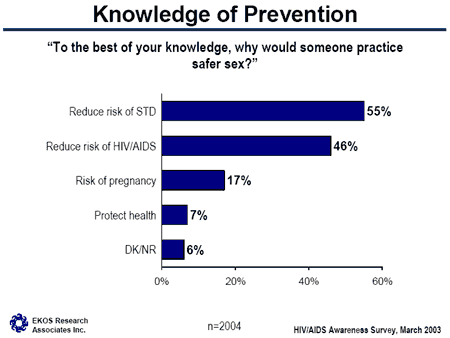
- Residents in Quebec are most likely to cite the reduced risk of HIV/AIDS (62 per cent), while those in Alberta, Ontario, and British Columbia are less apt to do so (36, 40, and 41 per cent, respectively). Women (49 per cent) and people between the ages of 45 and 64 are more likely to indicate this as the main benefit of safer sex (52 per cent). Individuals aged 25 to 34 are least likely to indicate this reason (37 per cent), as are university graduates. In fact, the lowest income earners are more likely to cite it (54 per cent). Individuals born outside Canada are less apt to indicate this reason (40 per cent).

- People between the ages of 25 and 44 are more apt to cite the reduced risk of sexually transmitted diseases (more broadly) as the main reason to practice safer sex (64 and 61 per cent, respectively), while the oldest are least likely to indicate this reason (44 per cent). University graduates are somewhat more likely to cite this as a benefit of safer sex (60 per cent). People who have children who are not yet in their teens and those who know someone with HIV are more likely to cite this reason (63 and 60 per cent, respectively), while those with a low self-rated knowledge of HIV/AIDS are less likely to do so (45 per cent).
- Residents of British Columbia are more apt to indicate the reduced risk of pregnancy (23 per cent), while those in Quebec and the Atlantic region are less likely to do so (11 per cent each). Youth are more likely to cite this as a benefit of safer sex (30 per cent), but this decreases with age (eight per cent among those over 65). Those with a middle level of education (some university) are also more likely to cite this benefit (27 per cent).
| So, residents of British Columbia, Alberta, and Ontario are less likely to cite health benefits, such as preventing the transmission of STDs as reasons for practicing safer sex. The same is true for foreign-born individuals and, surprisingly, university graduates. Seniors are less apt to cite the reduced risk of contracting HIV/AIDS and pregnancy, as are those with a low self-rated knowledge of HIV/AIDS and residents of Quebec and the Atlantic region. |
c) Knowledge of Testing
Canadians were asked if they know how someone can determine if they have HIV/AIDS. Eight in ten people (81 per cent) cited a blood test as a method of testing for the existence of HIV/AIDS without prompting. Eight per cent cited a physical examination or a visit to the doctor, while one per cent believes that self-diagnosis is a reliable test for HIV/AIDS. Six per cent were unable to provide an answer on methods for testing for HIV/AIDS.
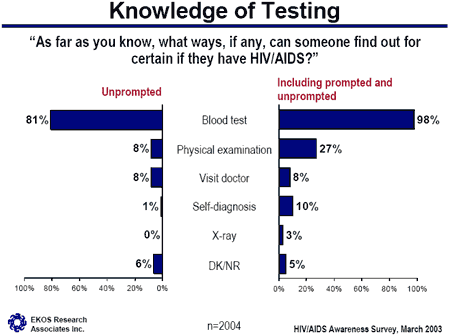
- People between the ages of 35 and 44 are more apt to cite a blood test as a method for testing for HIV/AIDS (90 per cent), while the youngest and oldest are less likely to do so (71 and 68 per cent, respectively). Women (85 per cent) are also somewhat more likely to cite blood tests than men. Those with higher education and income and people who have children (86 per cent) are more apt to cite this method, but those with low self-rated knowledge of HIV/AIDS are less likely to do so (69 per cent), as are residents born outside Canada (74 per cent).
- Residents of Quebec (13 per cent) and the lowest income earners (14 per cent) are somewhat more likely to cite a physical examination, while those in British Columbia are somewhat less likely to cite this test (two per cent).
- Youth and those with low self-rated knowledge of HIV/AIDS (15 and 13 per cent, respectively) are slightly more likely to indicate the general response of a visit to a doctor.
When presented with a list of possible methods of testing, awareness of the blood test as a test for HIV/AIDS increased to 98 per cent.5 Three in ten (27 per cent) believe that a physical examination will determine if someone has HIV/AIDS and eight per cent believe that a visit to a doctor is a reliable test. One in ten believe that self-diagnosis is a reliable test for HIV/AIDS and three per cent believe that X-rays can be used. Five per cent are not aware of any tests for the existence of HIV/AIDS.
- Residents of Quebec and lower education and income individuals are more apt to believe that there are methods of detection other than a blood test (i.e., physical exam, self-diagnosis and even X ray). Youth, seniors and men are also somewhat more apt to think that HIV can be detected with a physical examination.
d) Knowledge of Treatment
Most Canadians are of the opinion that HIV/AIDS treatments are at least somewhat effective in helping infected people lead normal lives (67 per cent "Somewhat" and 14 per cent "Very" effective). One in eight (13 per cent) believe that HIV/AIDS treatments are very effective and two per cent said that treatments are not effective at all. Four per cent are unable to gauge the effectiveness of HIV/AIDS treatments.
There has been a significant shift in opinion regarding the effectiveness of HIV/AIDS treatments. In 2002, slightly more than half of Canadians (56 per cent, 25 per cent fewer than in 2003) believed that HIV/AIDS treatments were at least somewhat effective in helping people with the disease lead better lives.6
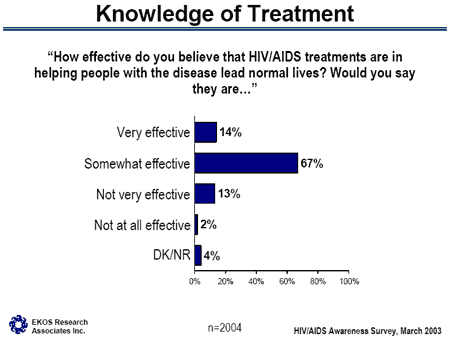
- People in Quebec are more likely to think that the treatments are not very effective (27 per cent).
- Residents in the Prairies and Alberta tend to think that the HIV/AIDS treatments are somewhat effective (75 and 72 per cent, respectively), and residents of Ontario are slightly more positive. Respondents born outside Canada are more likely to indicate that HIV/AIDS treatments are very effective in helping people with the disease lead normal lives (21 per cent).
- People over the age of 65 and those with low self-rated knowledge of HIV/AIDS are somewhat less likely to know how effective HIV/AIDS treatments have been (nine per cent in both groups).

e) Other Knowledge
Three-quarters of Canadians (77 per cent) know that HIV/AIDS cannot be cured (even if treated early). Nearly one in five (17 per cent) believe that it can be cured, if treated early, and five per cent do not know.
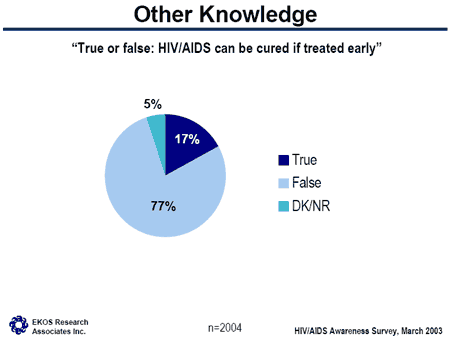
- Residents in Alberta (84 per cent) are more likely to know that HIV/AIDS cannot be cured, if treated early. This is also true for those between the ages of 25 and 34 (87 per cent). Those with higher education and income, parents of children who are not yet in their teens (84 per cent) and those with a high self-rated knowledge of HIV/AIDS (83 per cent) are more likely to know this.
- People born outside Canada are more likely to believe that HIV/AIDS can be cured, if treated early (27 per cent), as are senior citizens (29 per cent).
f) General Knowledge
Canadians were tested on a variety of general knowledge issues relating to HIV/AIDS. Eight in ten (84 per cent) know that, when a person has HIV/AIDS, his/her body is unable to defend itself against common illnesses and diseases. Three-quarters (77 per cent) agree that a person can have HIV for ten years or more without developing AIDS and six in ten (61 per cent) understand that AIDS is always fatal. Half of Canadians (49 per cent) agree that a number of very effective treatments currently exist for HIV/AIDS. In the case of the two latter statements, one in four Canadians disagree.
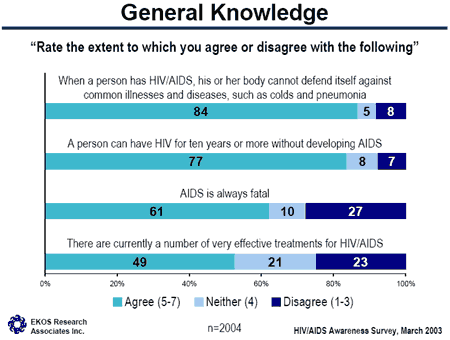
- People between the ages of 25 and 34 are somewhat more likely to agree with the definition of HIV/AIDS presented to them (90 per cent). Those between ages of 25 and 44 are more apt to agree that a person can have HIV for ten years or more without developing AIDS (82 and 83 per cent, respectively), while those over 65 are less likely to agree with this statement (62 per cent). Youth are less likely to agree that effective treatments for HIV/AIDS currently exist (40 per cent).
- Residents of Quebec are more likely to agree that HIV/AIDS is always fatal, while those in the Prairies and Ontario are less apt to think so (48 and 56 per cent, respectively). Residents of Ontario are more likely to believe that there are currently a number of very effective treatments for HIV/AIDS (55 per cent), while those in British Columbia are less likely to agree (43 per cent).
- Those earning between $60,000 and $79,000 are more likely to agree with the definition of HIV/AIDS presented to them (90 per cent). Individuals with higher education and income are more apt to agree that a person can have HIV for ten years or more without developing AIDS and surprisingly, the highest income earners are less likely to agree that AIDS is always fatal (55 per cent).
- People who have children who are not yet in their teens are somewhat more likely to agree with the definition of HIV/AIDS (90 per cent) and are more apt to agree that a person can have HIV for ten years or more without developing AIDS (84 per cent).
- Those who have a high self-rated knowledge of HIV/AIDS are more likely to agree that a person can have HIV for ten years or more without developing AIDS (85 per cent), that AIDS is always fatal (69 per cent), and that there are currently a number of very effective treatments for the disease (55 per cent).
- People who personally know someone with the disease are more apt to agree that a person can have HIV for ten years or more without developing AIDS (82 per cent).
- Members of a visible minority are more likely to agree that AIDS is always fatal (69 per cent), while Aboriginal Canadians are less likely to agree (54 per cent).
| In summary, men are slightly less likely to agree that there are currently a number of very effective treatments for the disease. Overall, seniors are less apt to know that a person can have HIV for ten years or more without developing AIDS. Residents of the Prairies and Ontario, as well as high income earners and Aboriginal Canadians are less likely to know that AIDS is always fatal. Men, youth, and residents of British Columbia are less apt to agree that a number of very effective treatments for HIV/AIDS currently exist. |
2.2 Government Initiative
a) Knowledge of Government Initiative (a)
Nearly four in ten Canadians (37 per cent) are aware that there is an overall federal government initiative regarding HIV/AIDS. Three in ten (28 per cent) do not believe that a federal government initiative exists and one-third does not know (34 per cent).
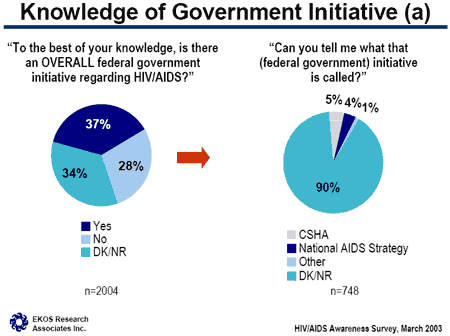
- Men are more likely to be aware of the existence of a federal government initiative on HIV/AIDS (42 per cent), as are higher education and income individuals, those with a high self-rated knowledge of HIV/AIDS (45 per cent) and individuals who personally know someone with HIV/AIDS (43 per cent).

- Seniors are less likely to know that there is a government initiative on HIV/AIDS (29 per cent).
Those who are aware of the federal government initiative on HIV/AIDS were asked if they knew its name. Only five per cent of Canadians know that it is called the Canadian Strategy on HIV/AIDS (CSHA). Four per cent believe that the initiative is called the National AIDS Strategy and one per cent identified the initiative as something else. The large majority (90 per cent) were unable to name the federal government's strategy on HIV/AIDS.
- Quebec residents are somewhat more likely to correctly name the initiative (even though only 10 per cent of these residents did).
- The lowest income earners are more likely to believe it is called the National AIDS Strategy (11 per cent).
b) Knowledge of Government Initiative (b)
More than four in ten Canadians (43 per cent) indicated that Health Canada is primarily responsible for coordinating the CSHA. Seven per cent cited the Government of Canada generally and four per cent indicated another federal government department or other body. Four in ten Canadians do not know who is responsible for CSHA.
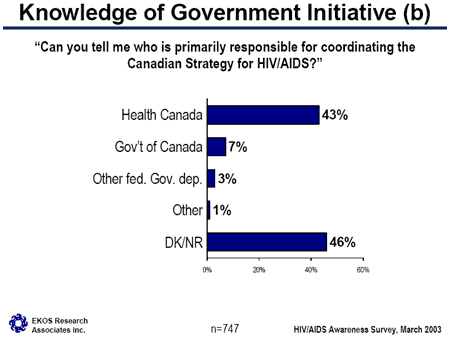
- Men (48 per cent) and higher education and income individuals are more likely to identify Health Canada as having the primary responsibility for CSHA. People who perceive a decreased risk of infection of HIV over the past five years are more likely to identify Health Canada (57 per cent). Youth (56 per cent), and people without a high school diploma (56 per cent), as well as those who perceive an increased risk are somewhat less likely to know who is responsible (51 per cent).
2.3 Self-Rated Knowledge
When asked to rate their own level of knowledge about HIV/AIDS, one in four reported a high level of confidence in their knowledge and seven in ten said they have at least a moderate level of knowledge about the disease. Five per cent say their knowledge about HIV/AIDS is low.
By comparison, only four per cent of Canadians have reported themselves to be very knowledgeable about Hepatitis "C", whereas 72 per cent said they are not very or not at all knowledgeable about this disease.7
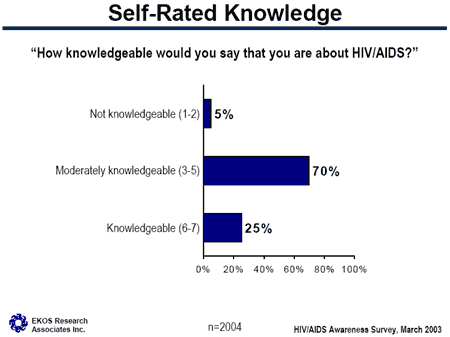
- Regionally, those in Quebec are more confident in their level of knowledge about HIV/AIDS (32 per cent), while residents in the Prairies are less likely to claim a high level of knowledge (17 per cent).
- Seniors are less likely to be knowledgeable about the disease (16 per cent).
- The level of self-rated knowledge increases with level of education (19 per cent among those without a high school diploma compared to 31 per cent among university graduates).
- Knowledge is higher among people who personally know someone with the disease (33 per cent).
2.4 HIV/AIDS Knowledge Index
A factor analysis was conducted to summarize items that reflect respondents' knowledge of HIV/AIDS, creating a knowledge index to be used in the analysis. The index included: methods of transmitting HIV (only unsafe/unprotected intercourse; sharing needles; kissing; contact with physical objects; mosquito bites; casual contact; sneezing or coughing; from mother to child during pregnancy were included); methods of detecting HIV (blood test; physical examination; self-diagnosis; X-ray); and agreement with the statements: HIV/AIDS can be cured if treated early; a person can have HIV for 10 years or more without developing AIDS; and when a person has HIV/AIDS, his/her body cannot defend itself against common illnesses and diseases. Each correct answer earned a point and each incorrect answer led to a reduction of a point. The scores were then summed up and placed in a cumulative index, ranging from -5 and +7. The results were collapsed into a high, medium and low level of knowledge. One in five respondents scored low, one-third scored medium and almost half scored high on the knowledge index.

- Reviewing some of the results on knowledge-related issues presented in this chapter so far, individuals who scored high on the knowledge index are more apt to have cited unsafe sex, sharing needles, blood transfusions and mother to child as methods of transmission.
- High scorers are also more apt to know that a blood test is the method to be used in detecting HIV. The lowest scorers were more likely to cite other tests.
- High scorers are more likely to have cited homosexual men and drug users as the more affected groups, while the low scorers are more apt to say they did not know.
- High scorers are more likely to recognize that a person can have HIV for many years without developing AIDS and that the body cannot defend itself against illnesses. They are also somewhat more apt to have agreed that AIDS is always fatal.
- High scorers on this index are no more likely to know about the federal government's strategy; however, they are more apt to know that such an initiative would be coordinated through Health Canada.
- Decima Express, Decima Research Inc., August 2002.
- Injection Drug Use Survey, Ipsos Reid, April 2002.
- Hepatitis "C" Awareness and Knowledge, Environics Research Group, February 2002.
- This may be related, in part, to the higher incidence of injection drug use on the lower Eastside of Vancouver.
- This is based on a combination of prompted and unprompted results.
- Decima Express, Decima Research Inc., August 2002.
- Hepatitis "C" Awareness and Knowledge, Environics Research Group, February 2002.
